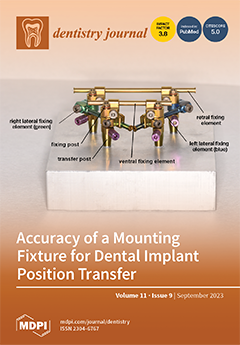The purpose of the study is to compare the hardness of different metallic brackets to enamel and to determine their chemical composition and microstructure. Five metallic brackets (0.022″ × 0.028″ inch) from seven orthodontic firms produced in different alloys (Discovery
® Smart/Empower
®/Genius
®2 Metal/Victory
TM series/Equilibrium
®/Damon Q) were chosen (
n = 35). The hardness of the brackets and enamel was measured using a microhardness tester. The study of the chemical composition of brackets was carried out on a single bracket per series. A scanning electron microscope (SEM) equipped with an energy dispersive spectroscopy (EDS) detector was used. Analysis of the chemical composition of metallic brackets was obtained with Oxford Instruments Ultim Max Aztec software. Metallic brackets’ hardness varied from 203 to 439 HV. A significant difference exists between Ti Equilibrium
® brackets, the rest of the brackets and the enamel (
p-value = 0.003). No significant difference was found between SS
a(stainless-steel alloy), Co-Cr
a(Cobalt-Chrome) brackets and the enamel. The chemical study confirms that the alloys used to produce metallic brackets validate all the data of the manufacturers except for Genius
®2 Metal; according to this study, they are considered to be Co-Cr
a alloys. The study of the composition of brackets made it possible to confirm manufacturers’ data. Genius
®2 Metal brackets, Empower
®2 and Victory
TM series brackets filled the properties needed for orthodontic treatment. The hardness of metallic brackets is influenced by the alloy used and manufacturing method. Co-Cr
a brackets with hardness comparable to enamel can be considered as an alternative to SS
a brackets in patients allergic to nickel.
Full article






